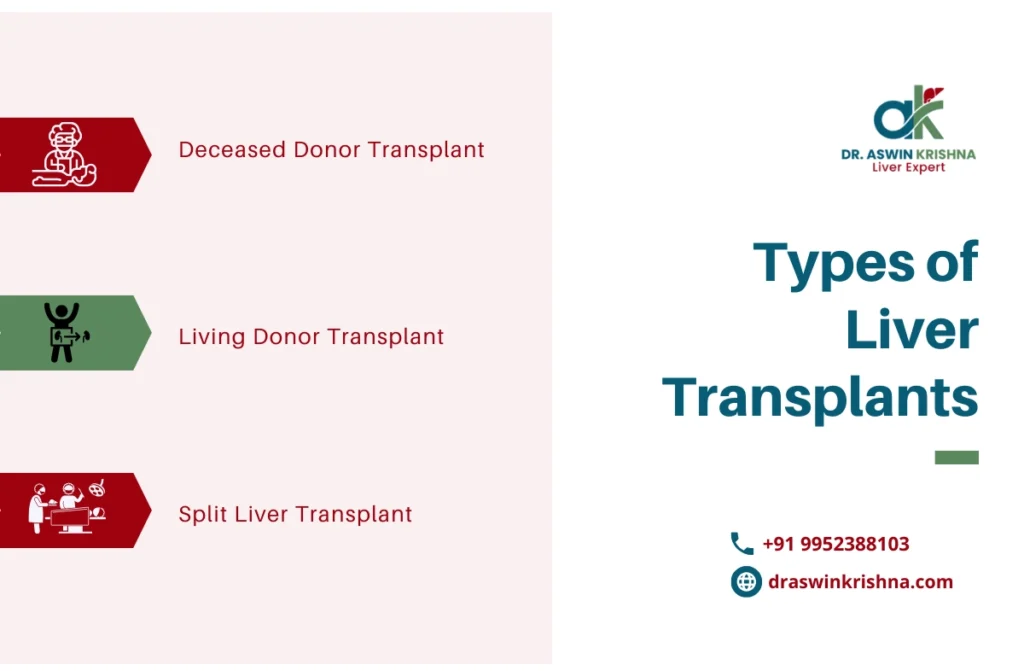Liver transplant facts are some of the most remarkable and inspiring insights in modern medicine. As a specialist in liver transplantation, Dr. Aswin Krishna has encountered countless stories of hope and recovery that showcase the transformative power of this procedure. For anyone navigating the complexities of liver transplants, understanding the details can make all the difference. Let’s delve into everything you need to know about liver transplant facts and address common concerns, such as how dangerous is a liver transplant and whether are liver transplants dangerous.
What is Liver Transplantation?
Liver transplantation is a surgical procedure that replaces a diseased liver with a healthy one, often from a donor. This procedure is usually a life-saving measure for individuals with severe liver disease or failure. The liver’s ability to regenerate and adapt makes transplantation a viable and often successful treatment option. Liver transplant facts reveal that this surgery can significantly improve a patient’s quality of life and survival.
What Are the Types of Liver Transplants?
There are three primary types of liver transplants:
- Deceased Donor Transplant: A healthy liver from a recently deceased individual is transplanted into the recipient.
- Living Donor Transplant: A segment of a liver is donated by a living person, typically a family member. The donor’s liver regenerates to its original size within a few months.
- Split Liver Transplant: A single donor liver is split into two parts and transplanted into two recipients. This technique maximizes the use of available livers.
Understanding these liver transplant facts helps in making informed decisions about treatment options.

9 Amazing Liver Transplant Facts You Need to Know
Liver transplantation is a life-saving procedure with a long history of medical progress. Below are liver transplant facts presented clearly so patients, families, and health professionals can understand what makes this operation unique and effective. These important facts give a balanced view of candidacy, outcomes, and what makes the liver special among organs.
- The liver can regenerate after donation. The liver is one of the few human organs that can regrow: a living donor can give part of their liver and both donor and recipient’s livers can regenerate to near-normal size within weeks to months. This is one of the most remarkable and important facts about the liver and a major reason living-donor transplantation is possible.
- There are two main transplant sources: deceased and living donors. Transplants come from donors after brain death or from healthy living relatives/friends who donate a portion of their liver. Choosing between these options depends on urgency, donor compatibility, and ethical considerations.
- Transplant candidacy is based on medical need and overall health. Not every patient with liver disease is eligible—evaluation includes cardiac, pulmonary, and psychosocial assessments, as well as testing for infections and substance-use stability. These protocols are part of the core liver transplant facts that affect waiting list placement.
- Immunosuppression is a lifelong trade-off. To prevent rejection, recipients take immunosuppressive drugs long-term; these lower the immune response that would otherwise attack the graft. While effective, these medicines increase infection risk and require regular monitoring and dose adjustments.
- Surgical complexity varies by case. Procedures range from standard whole-organ transplants to living-donor segmental transplants and split-liver techniques for two recipients. Surgical planning uses detailed imaging and teamwork among transplant surgeons, anesthesiologists, and specialized nurses.
- Outcomes have improved dramatically over decades. Advances in surgical technique, perioperative care, and immunosuppression have contributed to a rising liver transplant success rate for many indications. Long-term graft survival now allows many recipients to return to productive lives with ongoing medical follow-up.
- Transplants treat both acute and chronic liver failure. Indications include acute liver failure, cirrhosis from viral or metabolic causes, and certain cancers; transplantation replaces failing liver function rather than curing the underlying systemic disease in all cases. Selection requires careful staging and multidisciplinary discussion.
- Living-donor transplants reduce waiting-list deaths but require careful donor assessment. Because wait times for deceased organs can be long, living-donor transplants offer timely alternatives; however donor safety, anatomical suitability, and informed consent are paramount. Donors undergo thorough evaluation to minimize perioperative risk.
- Rehabilitation and long-term surveillance are essential parts of success. Beyond the operation itself, the pathway includes physiotherapy, nutritional support, and screening for complications and recurrence of disease. These follow-up practices strongly influence the real-world liver transplant success rate for recipients.
Step-by-Step Breakdown of the Liver Transplant Procedure
A clear, stepwise view helps set expectations. The summary below mixes short paragraphs with descriptive bullet points so each stage is understandable.
Preoperative evaluation (assessment and preparation)
- Extensive testing determines whether a person is a suitable candidate: blood typing, crossmatches, liver imaging, cardiac and lung function tests, infection screening, and a psychosocial assessment. Nutrition and optimization of other medical issues (diabetes, hypertension) also occur to reduce surgical risk.
- Listing and organ allocation: Patients who qualify are placed on the transplant waiting list and prioritized using established scoring systems based on severity and urgency. Allocation rules differ by region but emphasize fairness, compatibility, and urgency.
- Donor operation (for deceased or living donor): For deceased-donor grafts the procurement team removes the organ under sterile conditions; for living donors, the surgeon removes the planned liver segment with careful attention to bile ducts and blood vessels. Donor safety protocols and rapid transport preserve graft viability.
- Recipient operation — anesthesia and access: Under general anesthesia, the surgeon opens the abdomen and prepares to remove the diseased liver. Large-bore intravenous access and invasive monitoring are used because fluid shifts and bleeding can be substantial.
- Native liver removal and graft implantation: The diseased liver is removed while preserving major vascular structures; the new liver is implanted with reconnection of the hepatic artery, portal vein, hepatic veins (or inferior vena cava), and bile duct. This vascular reconstruction is the most delicate portion of the operation.
- Reperfusion and hemostasis: After the graft’s blood vessels are connected, blood flow is restored carefully to minimize reperfusion injury. Surgeons confirm no major bleeding and secure drains if needed before closing the abdomen.
- Immediate postoperative care: Patients go to an intensive care setting for hemodynamic monitoring, ventilatory support if needed, and early detection of complications. Immunosuppressive induction often begins in the operating room or immediately afterward.
Recovering from Liver Transplant
Recovery is multi-phase: immediate postoperative stabilization, early recovery in hospital, and long-term rehabilitation and surveillance. Below are descriptive points detailing what to expect and how patients progress.
- Hospital recovery (first days to two weeks): In the ICU and then the transplant ward, staff monitor liver function tests, coagulation, fluid balance, and infections. Pain control, wound care, and gradual mobilization begin early; patients usually start oral intake and physiotherapy as tolerated.
- Medication management and education: Patients receive individualized immunosuppressive regimens and prophylactic antibiotics or antivirals as needed. Education focuses on medication adherence, recognizing infection signs, and when to seek urgent care; families often participate in teaching sessions.
- Nutritional and physical rehabilitation: Nutritionists design protein-rich, balanced plans to support healing and liver regeneration. Exercise is progressed from walking to structured physiotherapy to rebuild strength and endurance over weeks to months.
- Return to normal activities and monitoring: Routine follow-ups include liver function tests, drug-level monitoring, and imaging when indicated. Some recipients can resume work and normal activities within months, while others require longer recovery depending on pretransplant condition.
- Special considerations for liver transplant patients: Liver transplant patients (living-donor recipients) often recover quicker because their graft may be non-cirrhotic and waiting time is shorter; however they still require the same strict follow-up. Donor recovery is also an essential part of the program and is tracked separately.
- Psychosocial recovery: Many recipients face emotional challenges—anxiety, mood changes, or adjustment disorders—so counseling and support groups help. Addressing mental health contributes directly to medication adherence and better outcomes.
Risk and Complications Involved in the Transplant
People commonly ask “how dangerous is a liver transplant?” or “are liver transplants dangerous?” — the honest answer is that while the operation carries significant risks, modern practice has minimized them and improved survival. Below are the main risks explained clearly.
- Perioperative risks (bleeding, infection, anesthetic complications): Major intraoperative bleeding can require transfusion; infections are a key concern due to immunosuppression. These risks are managed with expert surgical technique, prophylactic measures, and vigilant post-op care.
- Graft rejection and immune-related complications: The immune system can attack the new liver; acute rejection occurs early and is usually treatable with adjustment of immunosuppression. Chronic rejection is less common but more difficult to manage and may lead to graft loss.
- Vascular and biliary complications: Narrowing or thrombosis of hepatic vessels can compromise graft blood flow, while bile leaks or strictures can cause cholangitis or jaundice. Interventional radiology and endoscopic procedures often treat these complications without repeat surgery.
- Infections and malignancy risk with long-term immunosuppression: Lifelong immune suppression raises susceptibility to opportunistic infections and certain cancers; prophylaxis, screening, and vaccination strategies mitigate some of this risk. This balance is central to answering “are liver transplants dangerous?”—they carry risks, but these are actively managed.
- Metabolic and medication side effects: Immunosuppressants can cause kidney dysfunction, hypertension, diabetes, and bone loss. Regular monitoring and medication adjustments reduce long-term organ damage and improve quality of life.
- Complication considerations for liver transplant patients: Liver transplant patients must be monitored for both recipient and donor complications; donors have a generally low complication rate but require scheduled follow-up to ensure complete recovery. Transparent informed consent addresses these trade-offs.
- How dangerous is a liver transplant compared to alternative treatments? For many end-stage liver diseases, transplantation offers the best survival and quality-of-life benefit despite surgical risk. The relative danger must be weighed against the high mortality and morbidity of untreated liver failure—transplantation often reduces overall risk in appropriately selected patients.
When Does One Require a Liver Transplant?
A liver transplant becomes necessary when the liver is no longer able to function properly due to conditions such as:
- Cirrhosis: Chronic liver damage that leads to scarring and liver failure.
- Acute Liver Failure: A sudden loss of liver function, often due to toxins or infections.
- Liver Cancer: When tumors in the liver cannot be treated effectively with other methods.
These scenarios highlight why understanding important facts about the liver is essential for timely intervention. For many patients, exploring liver transplant facts can provide clarity on the best course of action.
How Are Candidates for Liver Transplant Determined?
Eligibility for a liver transplant depends on various factors:
- Severity of Liver Disease: Measured by the Model for End-Stage Liver Disease (MELD) score.
- Overall Health: Candidates must be healthy enough to undergo surgery and recovery.
- Support System: A reliable support network is critical for post-transplant care.
These liver transplant facts underscore the rigorous evaluation process to ensure the best outcomes. Additionally, the question of how dangerous is a liver transplant often arises during evaluations, and patients are given detailed guidance to address these concerns.
How Do Donated Livers Become Available?
Livers for transplantation come from two main sources:
- Living Donors: Typically family members or close relatives who are a match.
- Deceased Donors: Individuals who have opted to donate their organs after death. These donations are facilitated through organ donation registries and hospitals.
These liver transplant facts highlight the importance of organ donation awareness. Many people also ask, are liver transplants dangerous? While the process involves risks, the benefits often outweigh them for those in need.
What Are the Survival Rates After a Liver Transplant?
Survival rates after a liver transplant are encouraging, with approximately 85% of patients surviving the first year. Long-term survival depends on factors such as adherence to medical advice, regular check-ups, and overall health. These liver transplant facts offer hope and perspective for patients and their families.
Conclusion
Liver transplant facts shine a light on the incredible advances in modern medicine and the resilience of the human body. As Dr. Aswin Krishna emphasizes, these procedures offer a new lease on life to those in need. If you have questions about liver transplants or want to learn more, don’t hesitate to reach out. Understanding these liver transplant facts can help you make informed decisions about your health and future.
Read also Liver Transplant Donor.



